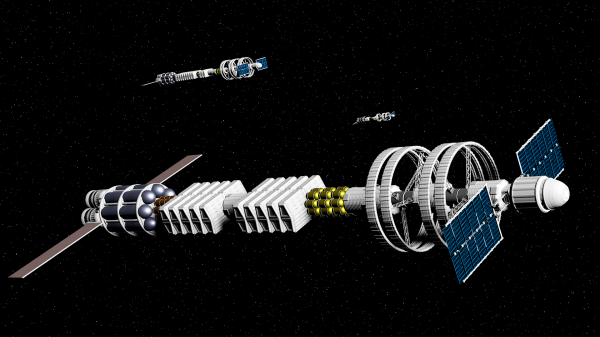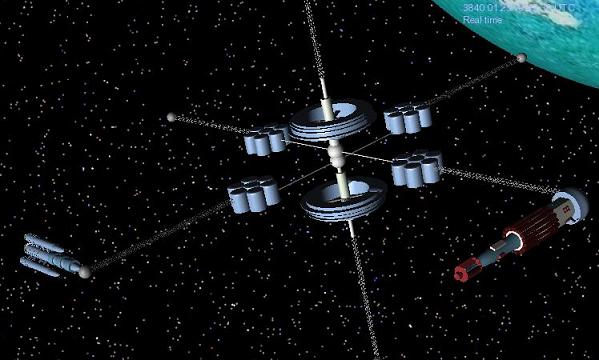BY LETTER
Colony Ships
Culture and Society > Cultural Factors > Interstellar Colonization
Technology > Application > Transportation > Interstellar Transport
Technology > Application > Transportation > Ships
Technology > Application > Transportation > Interstellar Transport
Technology > Application > Transportation > Ships
Interstellar Colonisation - Methods and Strategies | |
 Image from Alex Mulvey | |
| First Federation Era Colony Ships | |
Apart from energy another problem that faced the mission designers was the interstellar medium: because of the danger of impact even the top speed seemed likely to be no more than 0.3 c (even with heavy shielding). The energy requirements limited interstellar speed even further; the most efficient drives available could barely reach ten per cent of light speed.
This meant any interstellar flight would be a long one, several decades even to the closest stars. Several theoretical strategies were developed to ensure that a journey lasting decades or centuries would finally result in the establishment of a human colony;
1/ Methuselah ships. During the time that the first interstellar craft were being designed life extension technology was becoming increasingly effective. Long duration voyages could be crewed by long lived individuals. One problem would be boredom; this is where virtual reality tech would come in handy; over a voyage of hundreds of years long lived individuals could practice terraforming techniques in simulations over and over again. In the event few of the first colony ships were crewed by life extended humans; at that time they were cautious and risk-averse. More recent colony ships are often crewed by long lived clades, many with the ability to slow their own subjective time.
2/ Sleeper ships. Cryostasis technologies also emerged during the Interplanetary age, particularly vitrification, a way of immobilizing the cells contents using amorphous ice assisted by low temperature nanotech. Vitrification was not always reliable, and many early colonists were lost or damaged. In fact most early colony ships such as the Tau Ceti Shuttles used vitrification; later more advanced nanostasis ensured a better survival rate. It is important to realise that maintaining a human body in good condition while inactive is basically an information issue; if you can preserve information against the interstellar medium and the effects of cosmic rays then theoretically it is possible to preserve a human body and mind using nanotech biostasis with little or no alteration. Information protection is discussed below in a little more detail.
Most of the colony ships launched in the Solsys Era and the early First Federation Age were hibernation ships of some kind, mostly accelerated by boostbeam and decelerated by magsail. Since that time faster and more efficient methods of propulsion have been adopted.
3/ Generation ships. Enormous constructs supporting a breeding population of humans and associated food producing systems. Slower ships use less energy for propulsion per kilogram, but they then have to support populations of people for much longer periods - perhaps thousands of years on a typical slow interstellar flight. Generation ships are therefore extremely massive, and this extra mass requires very large amounts of power to accelerate up to interstellar speeds. Long flights require much more energy to sustain a closed ecological life support system; the absolute minimum energy requirement for a human is eight megajoules per day. Despite the reduced requirement for power in accelerating a generation ship, the extra mass and other overheads mean that generation ships are rarely used.
None were launched before the Great Expulsion, a few were launched after that event, including Valhalla Habitat. In most cases the Generation ships arrived much later than the lighter, faster hibernation ships and others. more.
4/ Seed Ships The size of the payload of an interstellar ship is extremely important, as a small increase in the mass of the payload can lead to a large increase in the mass of the fuel. So lightweight ships carrying only embryos or gametes were developed, equipped with artificial wombs and robot or vec carers to look after the developing infants when they were 'born' at the destination system. The parental robots in early seed ships were sophisticated devices with artificial bonding emotions and other instincts; in some cases (such as at Diwali) the sophisticated vecs declined to activate the zygote cargo, creating a society of their own. In fact many interstellar ships often included zygotes or gametes as a valuable part of their cargo, even if they were not strictly seed ships. More.
5/ Data only ships. A relatively small starship can carry massive amounts of data; digitized DNA, blueprints for automated factories to build space colonies, even perhaps electronically recorded human mindstates; these would be reassembled at the destination using nanotechnology into an entire civilisation. But how would a data-only ship preserve its cargo against degradation? Cosmic rays would destroy a simple database over time. Luckily this is an engineering problem; multiple copies of all data, parity checks and self repairing equipment could in theory resist data loss for millions, or even billions of years. Data-only ships were uncommon before the Integraton, although most unmanned probes and advance exploration ships carried some nanofacture capability. In many cases this capability could be upgraded by interstellar laser message, upgrading a simple probe into a data-transfer station; but in many other cases the probes themselves went rogue after contact with a-human AI entities (often from the so-called Diamond belt.)
The first successful manned interstellar flight was that of the Tsiolkovsky launched in 465 a.t to Tau Ceti. Similar missions followed to Sigma Draconis, Epsilon Eridani, Epsilon Indi, Psi 3 Orionis and elsewhere, before the Technocalypse threw Earth civilisation into chaos. The Great Expulsion that followed saw the hasty construction of many ark ships, like the Starlark and others of similar design.
 Image from Anders Sandberg | |
| A Data-only ship The Murmolyss Translation of Gordica, Metasoft. Length 350 meters, mass 94 million tons. The spacetime distortion is clearly visible. Since the tidal forces in most of the ship are in excess of 500 G, it is only used for solid state passengers and virtuals. The advertisement patterns offer random prognostic extelopedias. | |
Colonisation is still generally carried out by long distance craft rather than by wormhole, although today much faster conversion drive or reactionless drive craft are used, such as the example shown above. Another alternative is data transfer by electromagnetic comm beam, using the so-called engeneration system; this method is much more prone to data loss than the use of data-only vessels or solid state data packets, except when routed via microscale wormholes (a method favoured by the TRHN in particular).
 Image from Steve Bowers | |
| Two generations of colony ships at Digit Shipyard, Bolobo system. Left, a Skylark class ship from the first millennium a.t. right, a Pen-y-Darren class ship from the First Federation | |
See Also - Interstellar Colonisation before the First Federation Era
Related Articles
- Biostasis
- Cargo Ships
- Colonist
- Colony
- Cryonic Suspension
- Dyaushpitr Interstellar Colony Ship
- Early Interstellar Colonists
- Exploration, Interstellar
- Explorer Class
- Generation Ship
- Interstellar Colonisation Before the First Federation Era
- Landing Day - Text by Todd Drashner
A popular holiday among the baseline/near baselines of many systems. This is the day that their colonization venture first arrived on the planet or in the system they inhabit. Naturally it is a different day for every system. - Maids (phyle)
- Red (Tau Ceti Colony Ship)
- Seedship
- Starlark, The
- Upload
Appears in Topics
Development Notes
Text by Steve Bowers
Initially published on 13 September 2005.
Initially published on 13 September 2005.






